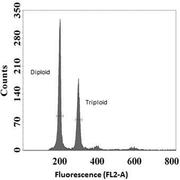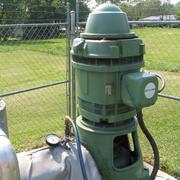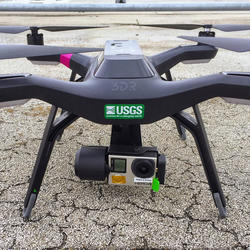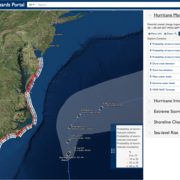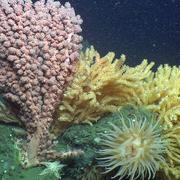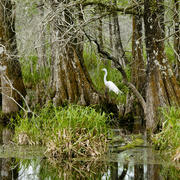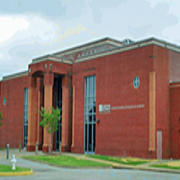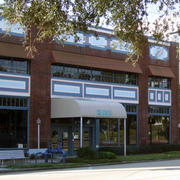Regions
Southeast
Regions L2 Landing Page Tabs
We conduct impartial, multi- and interdisciplinary research and monitoring to address a broad range of natural-resource issues that affect the quality of life of citizens and landscapes in the Southeastern United States and the Caribbean region.
We conduct impartial, multi- and interdisciplinary research and monitoring on a large range of natural-resource issues that impact the quality of life of citizens and landscapes of the Southeastern United States and the Caribbean region.
American Fisheries Society Imperiled Freshwater and Diadromous Fishes of North America
This website provides access to the list of imperiled freshwater and diadromous fishes of North America as determined by the 2008 American Fisheries Society (AFS) Endangered Species Committee (ESC) on Fishes.
Pilot Testing and Protocol Development of Apple Snail Suppression at Mandalay National Wildlife Refuge
The maculata apple snail (Pomacea maculata) has invaded many coastal and some inland areas in south Louisiana. Reports have indicated that the freshwater snails have significantly reduced the amount of submerged aquatic vegetation (SAV) and floating leaved vegetation (FLV) available for waterfowl and other wildlife.
A Website Tool for Predicting Triploidy in Larval Fish Spawns
Differentiating diploids from triploids at the earliest life stage possible allows for a more efficient use of resources including production time and rearing space. Thus, a reliable flow cytometric (FCM) method has been developed to discriminate triploids from diploids at the larval stage. In order to help simplify the process of differentiating triploids from diploids, we propose a simple...
Mapping Mangrove Condition
Mangroves have decreased worldwide due to human development, climate change and other forces. In southwest Florida, tremendous growth and development pressure has resulted in appreciable losses in mangrove wetlands.
Lower Mississippi-Gulf WSC - Baton Rouge Sediment Lab Price List - 2018 Fiscal Year
LOWER MISSISSIPPI-GULF WSC - BATON ROUGE SEDIMENT LAB PRICE LIST - 2018 FISCAL YEAR
2018
FISCAL YEAR
(Effective date will begin with samples received
by the Laboratory after October 1, 2017)
Ozark Plateaus Groundwater Availability Study
The U.S. Geological Survey's Groundwater Resources Program (GWRP) is conducting an assessment of groundwater availability throughout the United States to gain a better understanding of the status of the Nation's groundwater resources and how changes in water use and climate may affect those resources.
...
Sparta Aquifer Recovery Project
The Sparta aquifer is Union County's only source of municipal and industrial ground water. Since development began in the early 1920's ground-water levels have declined more than 390 feet in some areas. As a result, Union was among five southern Arkansas counties designated as the state's first "Critical Ground Water Area" in 1996.
Partners include:...
Decision Support System for Sustainable and Adaptive Management of Beaver Lake - Arkansas
Short Title: Beaver Lake 3-D Modelin
Project Chief: Reed Green
Cooperator: Beaver Water District
Project Time Frame: October 2007 - present
Beaver Lake is a large, deep-storage reservoir located in the White River Basin in northwestern Arkansas and is...
Beaver Lake Water Quantity and Quality - Arkansas
Short Title: Beaver Lake Water Quality
Project Chief: Reed Green
Cooperator: Beaver Water District
Project Time Frame: 2000 - present
Beaver Lake, completed in 1963, is located in northwestern Arkansas and receives a majority of its water from three...
Ground-Water Data Network - Arkansas
Short Title: Ground-Water Data Network
Project Chief: Anna Nottmeier
Cooperators: Arkansas Natural Resources Commission, Arkansas Geological Survey, ...
Hydrologic Monitoring for the City of Hot Springs Early Flood Warning Information System - Arkansas
Short Title: Hot Springs Flood Warning System
Project Chief: Joseph Fleming
Cooperator: City of Hot Springs
Project Time Frame: 2008- present
In May 1990, a series of severe thunderstorms developed in the vicinity of Hot Springs with a total...
Lakes Maumelle and Winona - Arkansas
Short Title: Lakes Maumelle and Winona
Project Chief: William Green
Cooperator: Central Arkansas Water
Project Time Frame: 1989 - present
Lakes Maumelle and Winona are water-supply reservoirs for the Little Rock and North Little Rock metropolitan areas...
We conduct impartial, multi- and interdisciplinary research and monitoring on a large range of natural-resource issues that impact the quality of life of citizens and landscapes of the Southeastern United States and the Caribbean region.
USGS National Water Data PortalCurrent Conditions for Arkansas: Water Quality

To view current conditions for Arkansas Water Quality click here.
Arkansas Groundwater-Quality Network

To see information on the Arkansas Groundwater-Quality Network click here.
Hurricane Irma 2017 Event Support Map

Track Hurricane Irma data and resources.
Hurricane Harvey 2017 Event Support Map

Track hurricane data and USGS resources.
Coastal Change Hazards Portal

Interactive access to coastal change science and data for our Nation’s coasts. Information and products are organized within three coastal change hazard themes: 1) extreme storms, 2) shoreline change, and 3) sea-level rise. Each data item represents an individual research product, with some items grouped together as aggregates to show the breadth of the topic and make it easy to explore.
Real-time Water Use Sites - Arkansas

To view real-time water use sites for Arkansas click here.
Real Time Sediment Concentrations - Arkansas

To view real time sediment concentrations for Arkansas click here.
Real Time Nitrate Readings - Arkansas
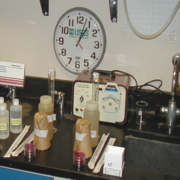
To see real time nitrate readings for Arkansas click here.
Arkansas Water Quality Mapper

To view the Arkansas Water Quality Mapper GIS interactive map click here.
Arkansas StreamStats
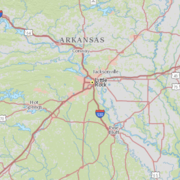
To see detailed information on Arkansas StreamStats as well as an interactive map click here.
Arkansas Sparta Recovery Groundwater Network
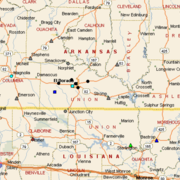
To see site information for the Arkansas Sparta Recovery Groundwater Network click here.
Arkansas Northern Lonoke County Groundwater Network

To see the map and site information for the Arkansas Northern Lonoke County Groundwater Network click here.
Shreveport Area—Caddo and Bossier Parishes Flood Map
Amite River Basin
River and Coastal Forecast Information
Lower Mississippi River Forecast Center, Slidell, Louisiana—(NWS)
Links to publications that contain maps of the sea floor or lake beds and the digital data used to create them.
This portal is a “go to” source for maps related to ocean and coastal mapping. Information is organized by geography or region, by theme, and by the year data was published.
River and Coastal Forecast Information
Mississippi and Ohio River 7-Day Summary and Forecast
The Union County Water Conservation Board with funding from the U.S. Environmental Protection Agency began a study in 2003 with the U.S. Geological Survey, the Union County Conservation District, Burns & McDonnell to monitor the impact of water-level recovery and water-quality characteristics of the Sparta aquifer system in southern Arkansas and northern Louisiana.
Understanding the effect of salinity tolerance on cyanobacteria associated with a harmful algal bloom in Lake Okeechobee, Florida
In an effort to simulate the survival of cyanobacteria asthey are transported from Lake Okeechobee to the estuarinehabitats that receive waters from the lake, a bioassayencompassing a range of salinities was performed. An overalldecline in cyanobacteria health in salinity treatments greaterthan 18 practical salinity units (psu) was indicated by...
Rosen, Barry H.; Loftin, Keith A.; Graham, Jennifer L.; Stahlhut, Katherine N.; Riley, James M.; Johnston, Brett D.; Senegal, SarenaLand area change in coastal Louisiana (1932 to 2016)
Coastal Louisiana wetlands are one of the most critically threatened environments in the United States. These wetlands are in peril because Louisiana currently experiences greater coastal wetland loss than all other States in the contiguous United States combined. The analyses of landscape change presented here have utilized historical surveys,...
Couvillion, Brady R.; Beck, Holly; Schoolmaster, Donald; Fischer, MichelleAssessing welfare of individual sirenians in the wild and in captivity
Assessing the welfare of wild populations of sirenians has required a “generalist” approach. The outcome has been a subjective decision as to whether what the observers are witnessing in an individual or group of animals is normal and whether that has positive or negative consequences. The understanding of sirenian welfare requirements, and a...
Flint, Mark; Bonde, Robert K.Human interactions with sirenians (manatees and dugongs)
There are three extant sirenian species of the Trichechidae family and one living Dugongidae family member. Given their close ties to coastal and often urbanized habitats, sirenians are exposed to many types of anthropogenic activities that result in challenges to their well-being, poor health, and even death. In the wild, they are exposed to...
Bonde, Robert K.; Flint, MarkHistorical changes in organic matter input to the muddy sediments along the Zhejiang-Fujian Coast, China over the past 160 years
The burial of sedimentary organic matter (SOM) in the large river-influenced estuarine-coastal regions is affected by hydrodynamic sorting, diagenesis and human activities. Typically, the inner shelf region of the East China Sea is a major carbon sink of the Yangtze River-derived fine-grained sediments. Most of the previous work concentrated on...
Chen, Li-lei; Liu, Jian; Xing, Lei; Krauss, Ken W.; Wang, Jia-sheng; Xu, Gang; Li, LiGulf Coast vulnerability assessment: Mangrove, tidal emergent marsh, barrier islands and oyster reef
Climate, sea level rise, and urbanization are undergoing unprecedented levels of combined change and are expected to have large effects on natural resources—particularly along the Gulf of Mexico coastline (Gulf Coast). Management decisions to address these effects (i.e., adaptation) require an understanding of the relative vulnerability of various...
Watson, Amanda; Reece, Joshua; Tirpak, Blair; Edwards, Cynthia Kallio; Geselbracht, Laura; Woodrey, Mark; LaPeyre, Megan K.; Dalyander, Patricia (Soupy)Prevalence of Batrachochytrium dendrobatidis and B. salamandrivorans in the Gulf Coast Waterdog, Necturus beyeri, from Southeast Louisiana, USA
The globally widespread amphibian fungal pathogen Batrachochytrium dendrobatidis (Bd) has been linked to amphibian declines worldwide (Lips et al. 2006; Skerratt et al. 2007). In Louisiana, USA, Bd has been found in several amphibian species (Chatfield et al. 2012; Rothermel et al. 2008), but to our knowledge no population-level die-offs have been...
Glorioso, Brad M.; Waddle, J. Hardin; Richards-Zawacki, Corinne L.Global hotspots and correlates of alien species richness across taxonomic groups
Human-mediated transport beyond biogeographic barriers has led to the introduction and establishment of alien species in new regions worldwide. However, we lack a global picture of established alien species richness for multiple taxonomic groups. Here, we assess global patterns and potential drivers of established alien species richness across...
Dawson, Wayne; Moser, Dietmar; van Kleunen, Mark; Kreft, Holger; Pergl, Jan; Pysek, Petr; Weigelt, Patrick; Winter, Marten; Lenzner, Bernd; Blackburn, Tim M.; Dyer, Ellie; Cassey, Phillip; Scrivens, Sally-Louise; Economo, Evan P.; Guenard, Benoit; Capinha, Cesar; Seebens, Hanno; Garcia-Diaz, Pablo; Nentwig, Wolfgang; Garcia-Berthou, Emili; Casal, Christine; Mandrak, Nicholas E.; Fuller, Pam L.; Meyer, Carsten; Essl, FranzMangrove species' responses to winter air temperature extremes in China
The global distribution and diversity of mangrove forests is greatly influenced by the frequency and intensity of winter air temperature extremes. However, our understanding of how different mangrove species respond to winter temperature extremes has been lacking because extreme freezing and chilling events are, by definition, relatively uncommon...
Chen, Luzhen; Wang, Wenqing; Li, Qingshun Q.; Zhang, Yihui; Yang, Shengchang; Osland, Michael J.; Huang, Jinliang; Peng, CongjiaoHow do en route events around the Gulf of Mexico influence landbird populations
Habitats around the Gulf of Mexico (GOM) provide critical resources for Nearctic–Neotropical migratory landbirds, the majority of which travel across or around the GOM every spring and fall as they migrate between temperate breeding grounds in North America and tropical wintering grounds in the Caribbean and Central and South America. At the same...
Cohen, Emily B.; Barrow, Wylie C.; Buler, Jeffrey J.; Deppe, Jill L.; Farnsworth, Andrew; Marra, Peter P.; McWilliams, Scott R.; Mehlman, David W; Wilson, R. Randy; Woodrey, Mark S; Moore, Frank R.Host-dependent differences in resource use associated with Anilocra spp. parasitism in two coral reef fishes, as revealed by stable carbon and nitrogen isotope analyses
The role of parasites in trophic ecology is poorly understood in marine ecosystems. Stable isotope analyses (SIA) have been widely used in studies of trophic ecology, but have rarely been applied to study the role of parasites. Considering that some parasites are associated with altered host foraging patterns, SIA can help elucidate whether...
Welicky, Rachel; Demopoulos, Amanda W.J.; Sikkel, Paul C.Nocturnal arboreality in snakes in the swamplands of the Atchafalaya Basin of south-central Louisiana and Big Thicket National Preserve of Southeast Texas
The southeastern United States is home to a diverse assemblage of snakes, but only one species, the Rough Greensnake (Opheodrys aestivus), is considered specialized for a predominantly arboreal lifestyle. Other species, such as Ratsnakes (genus Pantherophis) and Ribbonsnakes/Gartersnakes (genus Thamnophis), are widely known to climb into...
Glorioso, Brad M.; Waddle, J. HardinWater Well Constrution Reports entered online.
Louisiana coastal wetland change rates over time
Graph of land area change rate in coastal Louisiana from 1932–2016. The red line approximates the long-term land area change rate. 95 out of 100 statistical analyses would produce a very similar trend (dotted blue lines). Credit: USGS
Estimated and measured bathymetry offshore of Madeira Beach, Florida
Estimated and measured ocean depths (bathymetry) from Madeira Beach, Florida. Each panel shows same geographic area. m = meters. Left: Snapshot transformed from original oblique camera view to overhead “map” view. Middle: Bathymetry estimated by applying cBathy algorithm to July 2017 video imagery. Right: Bathymetry measured with sonar in February 2017. Despite being based
...Southeastern Bat with P. destructans Fungus
This southeastern bat (Myotis austroriparius) from Alabama shows signs of infection from the Pseudogymnoascus destructans fungus that causes white-nose syndrome in bats. The USGS National Wildlife Health Center later confirmed white-nose syndrome in this animal, marking the first time that WNS was found in a southeastern bat. As of June 2017, the species joins eight other
...Quadcopter's photos can be used to measure dune erosion
The 3DR Solo with GoPro Hero4 camera and gimbal. Coming to a survey area near you soon. Photo credit: Shawn Harrison, USGS. This photo was taken during USGS unmanned aerial systems (drone) pilot training. Two training sessions were held - one in February-March 2017 in Santa Cruz, California and the second in April 2017 in Gainesville, Florida. This photo
...Tropical Storm Nate's Forecasted Effect on Gulf Beaches
Tropical Storm Nate's predicted effect on Northern Gulf sandy shorelines, based on landfall as a Category 1 hurricane, is shown at three intensities. Outer band: Dune erosion. Middle band: Dune overwash. Inner band: Dune inundation, with potential flooding behind the dune. Credit: USGS Coastal Change Hazard Portal.
USGS Hurricane Preparedness
Before a hurricane, USGS Scientists undertake a data collection effort of a grand scale. They install a temporary mobile network of sensors along the coasts to collect additional data on the intensity of storm surge, one of the most dangerous elements of a hurricane. This effort provides critical information that allows various USGS partners and emergency responders to
...Boat thrown onto land from Hurricane Irma's surge at a ramp in Florida
Boat thrown onto land from Hurricane Irma's surge at a ramp in St. Augustine, Florida
Areas to be surveyed on first Deep SEARCH research cruise
Map of target areas to be surveyed during the first phase of the Deepwater Atlantic Habitats II study,
DEEP SEARCH, including seep targets. USGS image.
Study area for first Deep SEARCH research cruise
Map of target areas to be surveyed during the first phase of the
Deepwater Atlantic Habitats II study, DEEP SEARCH, including seep targets. USGS image.
Hurricane Irma on the Move
Satellite Image of Hurricane Irma on September 5, 2017. Photo by NASA/NOAA GOES Project
Preparing to measure Irma's storm surge in Puerto Rico
Along the northeast coast of Puerto Rico, USGS hydrologic technician Francisco Almanzar surveys reference elevation points to ensure the accuracy of water level data. Almanzar and other USGS employees installed nine storm surge sensors along the coast on Labor Day, Monday, Sept. 4, 2017 as Hurricane Irma approached.
Developing Effective Drought Monitoring Tools for Farmers and Ranchers
This webinar was conducted on August 7, 2017 as part of the USGS National Climate Change and Wildlife Science Center’s Climate Change Science and Management Webinar Series, held in partnership with the USFWS National Conservation Training Center.
Webinar Summary: The South Central U.S. is one of the main agricultural regions in North America: annual agricultural
...Coral reef expert Caroline Rogers was the only USGS employee in the Virgin Islands when the Category 5 storm hit.
A study finds that although the “wilderness breach” created by Hurricane Sandy in 2012 has reached a relatively stable size and location, the channel and shoals will keep changing in response to weather. Related research shows the breach isn’t likely to increase storm-tide flooding in Great South Bay.
Editor’s note: This story was updated at 2 pm Saturday, October 7. For the latest graphic showing USGS predictions of the sandy coastal areas likely to be affected by Hurricane Nate, click here.
More information about USGS science in response to Hurricane Nate is at www.usgs.gov/nate
Reporters: Do you want to accompany a USGS field crew as they work in the field to document how high the flood waters and storm surge from Hurricane Irma reached around the Jacksonville, Tampa and Fort Myers Areas?
If so, please contact Jeanne Robbins, jrobbins@usgs.gov, 919-571-4017.
To learn more about USGS’ role providing science to decision makers before, during and after Hurricane Maria, visit the USGS Hurricane Maria page at https://www.usgs.gov/maria.

This page contains the weekly highlights from the Lower Mississippi-Gulf Water Science Center for the week of 9/112017 - 9/15/2017! Please take a look and see what we have been up to!
Editor’s note: this news release will be updated online with more information on the streamgage records being set in Florida as it becomes available
Scientists beginning a three-week research cruises to study deep-sea corals, canyons and seeps departed from Norfolk, Virginia on September 12 after a one-day delay due to the effects of Hurricane Irma. USGS research oceanographer Amanda Demopoulos is the lead scientist for this cruise, the first of three planned as part of a four-and-a-half year study.
To learn more about USGS’ role providing science to decision makers before, during and after Hurricane Irma, visit the USGS Hurricane Irma page.
To learn more about USGS’ role providing science to decision makers before, during and after Hurricane Irma, visit the USGS Hurricane Irma page.
To learn more about USGS’ role providing science to decision makers before, during and after Hurricane Irma, visit the USGS Hurricane Irma page.
A non-native insect infestation may not be the only factor involved in the ongoing die-back of a marsh grass in the Mississippi River’s “bird foot delta,” the ecologically and economically important part of coastal Louisiana where the river meets the Gulf of Mexico.













